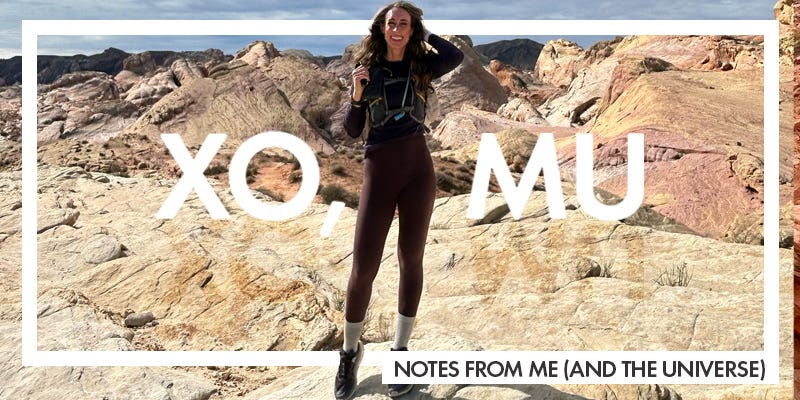How to prepare for hiking season
Spring is almost here, and the mountains are calling! Start elevating your fitness now.
This issue is sponsored by LMNT Electrolytes. One hundred percent of people I have given these to on the trail have said at the end, “WOW, those made a huge difference in my energy levels! Where can I get them?” Get a free LMNT 8-pack sampler with any drink mix purchase.
I got a taste of spring hiking last week in Las Vegas, where the weather was 60 and partly cloudy, and the elevation was far lower than Salt Lake City. It was a fantastic re-entry after a long, cold winter, but also a stark reminder that I’m not in hiking-at-11,000-feet shape right now.
This happens every winter with my seasonal training, so I’m not worried. I’ve spent the winter lifting heavier and doing different forms of cardio, and come May I’ll be ready to start running and hiking in earnest again. But in the winter, I do keep a few exercises in my repertoire to help me transition back into hiking faster and with more ease.
Here is my tried-and-true “get ready for hiking” plan, so you can hit the trails in the spring with vim and vigor.
Cardio
Hiking, especially at altitude, requires a solid set of lungs. If you don’t live at altitude, you can still train for the mountains with a combination of walking, rucking, running, and/or short bursts of HIIT designed to improve VO2 max and aerobic fitness.
VO2 max: Volume of O2 (oxygen) your body can use during exercise; a measure of cardiorespiratory fitness. The higher your VO2 max, the more oxygen your body can convert to energy. This is especially important during aerobic activities like hiking!
Walking: Walking, sometimes fast, sometimes uphill, is great training for hiking. After all, most trails are just walking uphill with obstacles. (Remember that any time you get intimidated.) If you’re on a treadmill, play around with adjusting your speed and incline to mix things up.
Rucking: Walk with weight, whether it’s a rucksack, plate carrier, weighted backpack, or weighted vest. Adding weight to your walks improves cardiovascular fitness, strength, and balance, and can prepare you for day hikes carrying 3 liters of water and other necessities.
Running: Don’t be intimidated—you can go as slow as you need. (If it’s faster than your fast walking pace, it 100% counts as running.) You could throw periods of slow jogs into your walks, do specific walk/run workouts, or just go for a run (if you’re already a runner).
Other forms of cardio: You can also row, stair climb, ski erg, bike or Airdyne, swim, cross country ski, drag a sled, or anything else that gets your heart rate up and your lungs working hard.
HIIT: While you’re generally not sprinting during a hike, doing short bursts of HIIT can definitely improve your VO2 max. Try a tabata protocol (20 seconds on, 10 seconds off, repeat x 8); a kettlebell swing ladder (like 1 swing + 1 breath, 2 swings + 2 breaths, up to 10 swings + 10 breaths, back down to 1); short bursts on the rower/treadmill/ski erg (I like 30 seconds on, 1:00 rest x 20); or any other HIIT protocol you like.
Hiking, hydration, and electrolytes
Hydration and electrolyte balance on the trail can mean the difference between finishing strong and tapping out early. I add 2 packs of LMNT Electrolytes to my 3L water reservoir, and have another 40 oz. + 1 pack in the car just in case. LMNT replenishes precious sodium lost through sweat, which helps your performance on the trail and makes your water even tastier. Using LMNT can help you prevent headaches, fatigue, and nausea on the trail—and keep you energized, focused, and muscle cramp-free all the way to the summit.
Stock up for hiking season now and get a free sampler 8-pack of all of LMNT’s core flavors with any purchase—including their fan-favorite Chocolate Medley box.
Strength
Hiking also requires a lot of strength, especially in your legs, glutes, and core. There are a few exercises I really like doing during the winter to make those steep ascents feel less challenging. (Note, you can do any leg exercises that you like! I don’t happen to do leg presses, calf raises, or hack squats, but those are great for leg strength too.)
Step-ups: Stepping up onto a box, bench, or stair mimics hiking nicely. This can be a form of cardio if you do sets of 50 or 100, but can also help you build leg and glute strength. Focus on keeping your weight on your up leg (not the trailing leg), push through the heel of the up foot, and don’t rebound off your down leg on the way back up. Adjust the height of the box to your workout; I use a low box (20”—low for my legs!) for long step-up workouts, a medium box for weighted step-ups, and a high box for glute-focused work.
Mix up your step-ups! I learned this trick from Krissy Harcombe: You can do more than just step up and down in a straight line. Try stepping up and over; or up, across, 90 degree turn, and down—anything that mimics the real-world challenges found on a hiking trail (downed logs, big boulders, uneven terrain).
Heel-taps: These are another glute-focused exercise that also challenge your balance. Use a low box for this, or the stairs in your house. Lower down under control to lightly tap your heel to the floor at your side (not in front of you), then return to standing. As you get stronger, you can use a higher box.
Squats and deadlifts: You can do a zillion variations here, from barbell to kettlebell to dumbbells to bodyweight. These two movements work your core, quads, hamstrings, and glutes. Squats also require good ankle flexion, and are a good assessment for your overall lower body mobility. I’m squatting and deadlifting, all year round—sometimes heavy, sometimes lighter.
Lunges: These are another staple exercise that you can slice and dice any number of ways. Lunge forwards, backwards, or to the side. Walking lunges are a favorite, and adding a mild descent can help prepare your quads and knees for the trail descent. Do them with a barbell, dumbbells, kettlebell, ruck pack, sandbag, or unweighted.
Sled drags (especially backwards): Sled drags are great for cardio, but also great for leg and core strength. (You can weight them heavy and go slow, or weight them light and go fast—dealer’s choice.) Walking backwards (pulling the sled with a harness or while holding onto straps) is excellent for knee strength and stability too.
Core: I like core exercises that mimic the real world. I don’t do a lot of sit-ups, but I do carry things overhead (like a dumbbell or kettlebell); do single-arm farmer’s carry (down by my side); and march with weights. I also love dead bugs, weighted or unweighted, any variation. Really, any core exercise is good here—but please do something, as you’ll want that support when you have a pack on your back.
Don’t forget upper body! You don’t use your chest, biceps, triceps, or lats a ton during hikes unless you’re scrambling or rock climbing, but I still throw in upper body work regularly! Push-ups, shoulder presses, chest presses, pull-ups, and more help keep those muscles strong during my hiking and running season.
Mobility, stretching, and balance
If you’re not already, now is a great time to add a bit of mobility, stretching, and/or balance to every workout. You need your ankles, knees, and hips to be ready for the range of motion required to hike, and mobile enough that a slip or stumble doesn’t take you out. Pre-hike warm-ups can help you feel more confident starting out, and post-hike stretching can help reduce any muscle soreness the next day.
I have a long list of mobility drills I’ve picked up over the years, and balance drills from my physical therapist and yoga practice. I won’t share the full list here as they’re quite tailored to my body, but you can find free YouTube videos that walk you through a pre-hike mobility routine, balance exercises, and plenty of ideas for pre- and post-hike stretching.
Happy trails!
If you haven’t had an exercise routine or you’re new to hiking, don’t sweat it. As I said, hiking is just walking, and you could get outside tomorrow and conquer a trail as long as it was suited to your ability. Much like with running, you can hike any way you want. Go as slow as you need to be comfortable, turn around whenever you want to, and choose trails that pose the right level of challenge for your first few hikes of the season.
Oh, and don’t forget to pack the LMNT!





I’m so excited to come to SLC on Wednesday!! It’s supposed to be nicer there than here (Annapolis-ish) but then get COLD on Sunday, the day I have free. Any recommendations for how to occupy my time on a freezing cold Sunday in SLC?